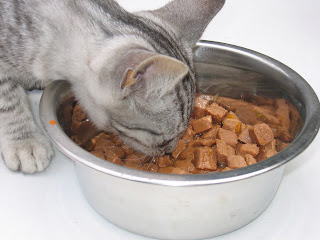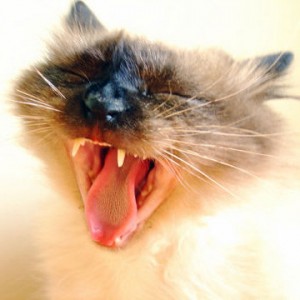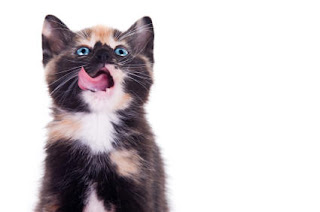Although a cat is an obligate carnivore, most cat foods contain meat and plant ingredients with vitamins, minerals and nutrients added. The food must include taurine or it may develop retinal degeneration and go blind.
The food usually comes in a dry(kibble) or wet version. Dry food can contain up to 10% of moisture. Depending on the food, it contains some level of carbohydrates which a cat has no need for because it produces glucose from protein. Dry food can be left out for longer periods than wet food. Some believe it aids in the control of dental calculus. Overall it is more convenient and cost effective than wet food.
Wet food contains up to 78% of moisture. Some believe the increased water content over dry food is beneficial in reducing constipation, obesity, renal failure and urinary tract disorders. Fish is a common ingredient of wet food but to much of it can cause yellow fat disease.
Other alternatives are prescription food to treat certain ailments and home made food. If using homemade food, it is important that the animal is getting the necessary nutrients which may have to come from supplements.
Another alternative is vegetarian or vegan food. Unfortunately, vegetables do not contain the nutrients that meat provides. Adding supplements to the vegan food may not be adequate and can cause urine acidity problems. There is a debate if a vegan diet is good for a cat.
Malnutrition can occur if the diet is not adequate. Excessive feeding of raw, freshwater fish can cause a thiamine deficiency. An exclusive liver diet can cause a Vitamin A toxicity. Many organic, natural or vegan diets may not have the correct balance of nutrients causing malnutrition and other diseases.
There are many brands of food on the market. The basic needs are:
- Protein from meat, fish or poultry.
- Taurine.
- Vitamins, minerals, enzymes and fatty acids.
- Water.
When reading the food label look for:
AAFCO compliance with requirements for complete and balanced. The criteria for complete and balanced is:
* The food must pass feeding tests for the life stage recommended on the label
* The composition of the food must meet or exceed nutrient levels established by AAFCO
* Preservatives, at the level included in commercial pet foods, have never been scientifically demonstrated to cause any problems in pets (or people) at less than 100 times the levels found in such foods. On the other hand, the current trend for many cat food manufacturers is toward using natural preservatives, such as vitamins C and E.
Protein source - chicken, lamb or beef rather than meat.
Protein source should be the first ingredient especially on canned food.
Expiration date for freshness.
Avoid foods with labels that have:
Words like by-products, meat and/or bone meal or animal digest.
Chemical preservatives like BHA, BHT, ethoxyquin or propyl gallate.
Corn meal as a filler.
Excessive carbohydrate fillers.
If unsure of a proper diet, consult with a veterinarian.
The food usually comes in a dry(kibble) or wet version. Dry food can contain up to 10% of moisture. Depending on the food, it contains some level of carbohydrates which a cat has no need for because it produces glucose from protein. Dry food can be left out for longer periods than wet food. Some believe it aids in the control of dental calculus. Overall it is more convenient and cost effective than wet food.
Wet food contains up to 78% of moisture. Some believe the increased water content over dry food is beneficial in reducing constipation, obesity, renal failure and urinary tract disorders. Fish is a common ingredient of wet food but to much of it can cause yellow fat disease.
Other alternatives are prescription food to treat certain ailments and home made food. If using homemade food, it is important that the animal is getting the necessary nutrients which may have to come from supplements.
Another alternative is vegetarian or vegan food. Unfortunately, vegetables do not contain the nutrients that meat provides. Adding supplements to the vegan food may not be adequate and can cause urine acidity problems. There is a debate if a vegan diet is good for a cat.
Malnutrition can occur if the diet is not adequate. Excessive feeding of raw, freshwater fish can cause a thiamine deficiency. An exclusive liver diet can cause a Vitamin A toxicity. Many organic, natural or vegan diets may not have the correct balance of nutrients causing malnutrition and other diseases.
There are many brands of food on the market. The basic needs are:
- Protein from meat, fish or poultry.
- Taurine.
- Vitamins, minerals, enzymes and fatty acids.
- Water.
When reading the food label look for:
AAFCO compliance with requirements for complete and balanced. The criteria for complete and balanced is:
* The food must pass feeding tests for the life stage recommended on the label
* The composition of the food must meet or exceed nutrient levels established by AAFCO
* Preservatives, at the level included in commercial pet foods, have never been scientifically demonstrated to cause any problems in pets (or people) at less than 100 times the levels found in such foods. On the other hand, the current trend for many cat food manufacturers is toward using natural preservatives, such as vitamins C and E.
Protein source - chicken, lamb or beef rather than meat.
Protein source should be the first ingredient especially on canned food.
Expiration date for freshness.
Avoid foods with labels that have:
Words like by-products, meat and/or bone meal or animal digest.
Chemical preservatives like BHA, BHT, ethoxyquin or propyl gallate.
Corn meal as a filler.
Excessive carbohydrate fillers.
If unsure of a proper diet, consult with a veterinarian.


